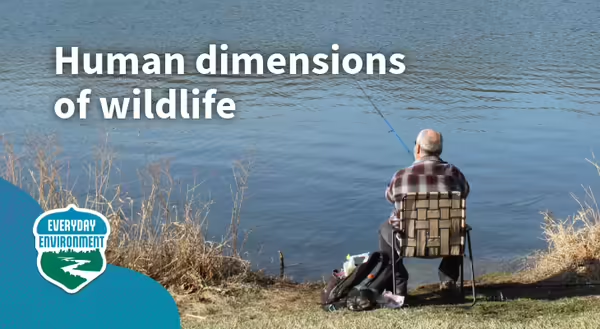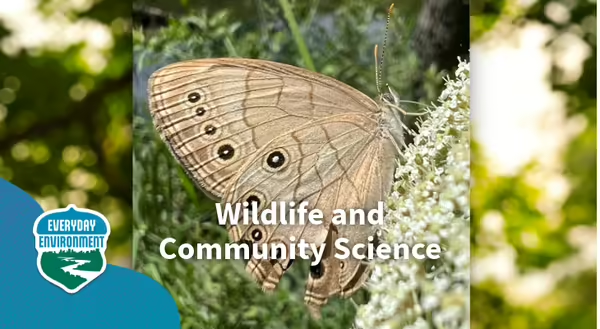Small changes have positive impacts on the environment.
Everyday Environment explores the intricate web of connections that bind us to the natural world. From water, air, energy, plants, and animals to the complex interactions within these elements, we aim to unravel the ties that link us to our environment. Through podcasts, blogs, webinars, and videos, you'll gain a deeper understanding of and appreciation for these connections in Illinois and beyond. Each fall and spring, we'll explore a new topic in detail, including wildlife, water, and climate.
Read the Blog Listen to the Podcast Watch the Webinars
What's next? Invasive species in spring 2026
The fall 2025 series explored Illinois wildlife. So, what's next? In the spring of 2026, we will explore the impacts of invasive species, the latest laws and research, tools for detection and reporting, and success stories of communities working to manage invasives.
In the meantime, stay connected!
Check out our previous season content below with blogs, podcasts, short videos, and webinars.
Visit your local county Extension office and connect with staff there with your nature questions.
See something cool in nature? Let us know! Send us your question or share your everyday nature observation with us at go.illinois.edu/EEconnect, and we may share it in a future blog or podcast.
Never miss an update! Join the Everyday Environment mailing list.
Now, Everyday Environment has even more tools and recommendations for you to explore, engage, and be a steward of the environment with small changes that have positive impacts on the world around us.
Webinars
In fall and spring, tune in to monthly "Voices from the Field" webinars to learn about wildlife research projects from University of Illinois scientists. Leave with tools and information to help protect the planet for generations to enjoy. All sessions are free.
Looking for previous programs? Recordings are posted several weeks after the live webinar.
Often heard and rarely seen, the eastern whip-poor-will and its namesake nighttime call is an iconic Midwestern woodland bird. But like many other insect-eating birds, its numbers are declining. University of Illinois avian researchers are working to uncover the secrets of where this elusive...
Box turtles are charismatic, long-lived turtles that are omnivorous and use both land and water ecosystems. These characteristics make them uniquely sensitive to the health of their environments and good indicators of overall ecosystem health. In the last 18 years, the Wildlife Epidemiology...

An unexpected turn: the human dimensions of wildlife

From observation to conservation through community science
Past Series
Wildlife, Fall 2025
Explore the collection of wildlife videos, blogs, and podcasts below.
Videos
Webinars: Uncovering the Winter Secrets of Whip-poor-wills, Saving the World, One Box Turtle at a Time
Teeny Tiny wildlife shorts: The House Centipede, the North American Wheel Bug, the Yellow Garden Spider, the Roly Poly
Blogs
Animals expand our understanding of the natural world
Hunting, fishing, and the numbers behind the traditions from 1960-2024
Where have all the quail gone?
How do you study something you can't see? Environmental DNA gives scientists clues about wildlife
Highway to harm – the hidden toll of roads on wildlife
Should you rescue that animal? Understanding injured wildlife
Return of bison revives biodiversity of one restored Illinois prairie
Fish hatcheries benefit everyone, anglers and non-anglers alike
Coyotes as sentinels: What wildlife reveal about public health
Tracking the armadillo expansion into Illinois
Digging into the plains pocket gopher, Illinois’ hidden soil builder
Why you should listen to Illinois wildlife
From observation to conservation through community science
An unexpected turn: the human dimensions of wildlife
Podcast Episodes
There's a snake in my basement!: wildlife encounters with Joy O'Keefe
Funding the wild: the role of outdoor recreation in conservation
Taking action for wildlife: The power of community science
A poster child for wildlife conservation: quail in Illinois
Environmental DNA basics: how we detect hidden life with Dr. Mark Davis
It's all edges: road ecology with Kevin Rohling
Wildlife in trouble: when to step in and when to step back
What role do bison play in restoring Illinois prairies?
An alien experience they just keep coming back for: fish hatcheries in Illinois with Kayleigh Smith
City dwellers: the Urban Coyote Research Project with Chris Anchor
Movement of Armadillos in Illinois with Agustin Jimenez
Gopher it: Uncovering the unique ecology of the plains pocket gopher
Get to know your neighbors: listening to Illinois wildlife with Brodie Dunn
Water Resources, Spring 2025
Explore the collection of climate change videos, blogs, and podcasts below.
Blogs
- What watershed do you live in? Diving into watershed basics
- Monitoring stream water quality with...bugs?
- Help prevent household substances from becoming aquatic contaminants
- Using stormwater to your advantage
- Be a Hero: How you can prevent the spread of aquatic invasive species
- Protecting our waterways from excess nutrients
- Tips for creating a rain garden to protect water, nature, and communities
- Reversing the Chicago River created ripple effects we still see today
- Communities face challenges and find solutions together to address aging and changing water infrastructure
- The groundwater guide: Where our water comes from and the challenges communities face
- Clean water costs money – Here's how communities calculate water rates
- Taking Care of Water is a Community Effort
Podcast Episodes
- From raindrop to river: State Hydrologist explains watershed basics
- Science is not just for the professionals: RiverWatch and community science
- What you should know about contaminants of emerging concern
- Rain Check: Creative ways to use stormwater to your advantage
- A gauntlet for Carp: invasives species in our waterways
- Nutrient loss in our waterways: the role of agriculture
- Rain gardens and nerding out over native plants
- Taking into consideration the next 100 years: the reversal of the Chicago River
- Taking a systems-based approach to community water management
- Protecting our water supply with helicopters? How communities are tackling water challenges
- Water Economics: The Pricing Puzzle
- From youth to adults: engaging our communities to learn about their water
Videos
Climate Change in Illinois, Fall 2024
Explore the full collection of climate change videos, blogs, and podcasts below.
Blogs
- Reduce methane generation with composting
- Exploring the Potential of Agrivoltaics
- Renewable energy offers benefits for our future
- How agricultural carbon markets are investing in policy and interest for farmers
- Saving the planet is child's play! Empower youth about climate change
- Adapting to climate change can have added health benefits
- Pollinators' complicated relationship with climate change
- What to expect with invasives and climate change
- Soil carbon addresses climate resiliency for the future
- The urban forest is a climate tool for all
- How plants respond to rising carbon dioxide concentrations
- Climate expert breaks down the basics of climate change
Podcast Episodes
- Coffee grounds are green: composting reduces methane and builds up soil
- Investigating solar energy and agriculture: agrivoltaics and climate change
- Exploring carbon markets as part of emissions reduction goals
- Cover Crops not Mudslides: empowering youth on climate change
- It’s all about risk: how climate change increases our risk of health concerns and how we can adapt
- Exploring the challenges facing pollinators
- Will invasive species be helped or hindered by climate change?
- Understanding soil as a system
- 708 million tons of carbon storage: Urban Forests and climate change
- Too Much of a Good Thing: A Plant’s Perspective on Climate Change
- Shifting to a Silver Lining: Climate Expert Talks Climate Change Basics
Videos
- An Introduction to Climate Change in Illinois
- How renewable energy transitions are happening in rural Illinois
- Can your lawn be climate friendly?
- An Interview with a Buckthorn Tree
- Reduce your energy use to help fight climate change
- Webinar: What Illinois Residents Should Know about Climate Change
- Webinar: Actions for Illinois Residents to Combat Climate Change
Do you know where your drinking water comes from? Illinois is a diverse state when it comes to water resources, and where your water comes from depends on how much is available, the quality of a water source, and its contamination risk. Explore sources of drinking water in Illinois, get an...
What’s in your water? Learn about common water pollutants, how your daily actions, indoor and outdoor, impact water quality, and how water is treated before returning to rivers and lakes. Simple tips to prevent pollution start with you.
This webinar was recorded on May 8, 2025. Find more...
Discover what climate change means for Illinois now and in the future and explore practical solutions. Learn how you can play a vital role in helping your community be healthier and more resilient to the effects of climate change. Don't miss this opportunity to be part of the conversation and...
While there are many strategies to reduce risk and adapt at global and regional scales, individuals can also take action.
In this video you will learn how you can address climate change in your home, landscape, and community, explore how different methods of managing your lawn,...
Connect with us!

Erin Garrett

Abigail Garofalo
